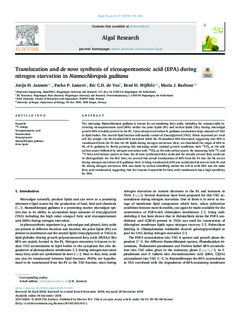| dc.contributor.author | Janssen, Jorijn H. | |
| dc.contributor.author | Lamers, Packo P. | |
| dc.contributor.author | de Vos, Ric C. H. | |
| dc.contributor.author | Wijffels, Rene Hubertus | |
| dc.contributor.author | Barbosa, Maria | |
| dc.date.accessioned | 2019-03-26T00:36:14Z | |
| dc.date.available | 2019-03-26T00:36:14Z | |
| dc.date.created | 2019-02-21T14:58:04Z | |
| dc.date.issued | 2018 | |
| dc.identifier.citation | Janssen, J. H., Lamers, P. P., de Vos, R. C. H., Wijffels, R. H. & Barbosa, M. (2018). Translocation and de novo synthesis of eicosapentaenoic acid (EPA) during nitrogen starvation in Nannochloropsis gaditana. Algal Research, 37, 138-144. doi: | nb_NO |
| dc.identifier.issn | 2211-9264 | |
| dc.identifier.uri | http://hdl.handle.net/11250/2591671 | |
| dc.description.abstract | The microalga Nannochloropsis gaditana is known for accumulating fatty acids, including the commercially interesting eicosapentaenoic acid (EPA) within the polar lipids (PL) and neutral lipids (NL). During microalgal growth EPA is mainly present in the PL. Upon nitrogen starvation N. gaditana accumulates large amounts of TAG in lipid bodies. The neutral lipid fraction will mainly consist of triacylglycerol (TAG). When expressed per total cell dry weight, the NL-localized EPA increased while the PL-localized EPA decreased, suggesting that EPA is translocated from the PL into the NL lipids during nitrogen starvation. Here, we elucidated the origin of EPA in NL of N. gaditana by firstly growing this microalga under optimal growth conditions with 13CO2 as the sole carbon source followed by nitrogen starvation with 12CO2 as the sole carbon source. By measuring both 12C and 13C fatty acid isotope species in time, the de novo synthesized fatty acids and the already present fatty acids can be distinguished. For the first time, we proved that actual translocation of EPA from the PL into the NL occurs during nitrogen starvation of N. gaditana. Next to being translocated, EPA was synthesized de novo in both PL and NL during nitrogen starvation. EPA was made by carbon reshuffling within the cell as well. EPA was the main fatty acid translocated, suggesting that the enzyme responsible for fatty acid translocation has a high specificity for EPA. | nb_NO |
| dc.language.iso | eng | nb_NO |
| dc.publisher | Elsevier | nb_NO |
| dc.rights | Attribution-NonCommercial-NoDerivatives 4.0 Internasjonal | * |
| dc.rights.uri | http://creativecommons.org/licenses/by-nc-nd/4.0/deed.no | * |
| dc.title | Translocation and de novo synthesis of eicosapentaenoic acid (EPA) during nitrogen starvation in Nannochloropsis gaditana | nb_NO |
| dc.type | Journal article | nb_NO |
| dc.type | Peer reviewed | nb_NO |
| dc.description.version | publishedVersion | nb_NO |
| dc.rights.holder | © 2018, The Author(s) | nb_NO |
| dc.subject.nsi | VDP::Matematikk og Naturvitenskap: 400::Zoologiske og botaniske fag: 480::Marinbiologi: 497 | nb_NO |
| dc.source.pagenumber | 138-144 | nb_NO |
| dc.source.volume | 37 | nb_NO |
| dc.source.journal | Algal Research | nb_NO |
| dc.identifier.doi | 10.1016/j.algal.2018.11.025 | |
| dc.identifier.cristin | 1679651 | |

